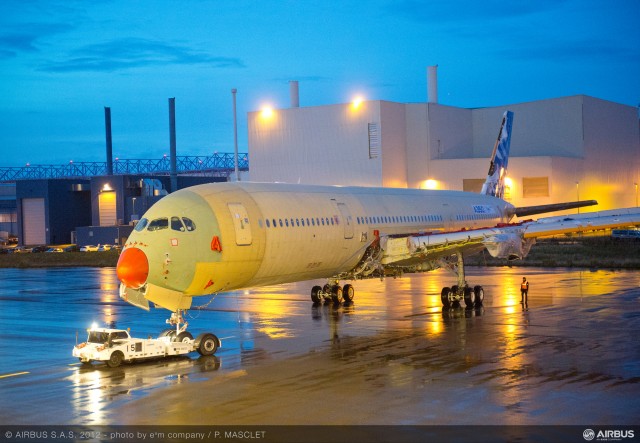
The first A350 XWB flight test aircraft has moved to the Station 30 ground test station at Airbus’ final assembly line in Toulouse, France following its structural assembly and initial electrical power-on in the facility’s main assembly hall (Station 40) . Image from Airbus. Click for larger.
This is a copy and paste from a press release issued by Airbus…
Airbus has successfully completed the main structural assembly and system connection of A350 XWB ’˜MSN1’ ’“ the first flight-test aircraft. The aircraft is depicted here on its wheels for the very first time moving out of the main assembly hall (Station 40) at the recently inaugurated ’œRoger Bteille’ A350 XWB Final Assembly Line in Toulouse. It then entered the adjacent indoor ground test station (Station 30).
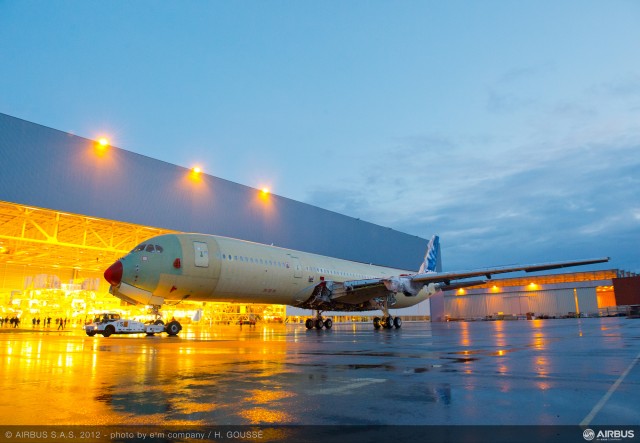
The structurally-complete no. 1 A350 XWB flight test aircraft is shown during its transfer at the Airbus final assembly line in Toulouse, France ’“ moving from Station 40 in the main assembly hall to the adjacent indoor ground test station (Station 30) . Image from Airbus. Click for larger.
The assembly work performed in Station 40 included the successful electrical power-on of the aircraft’s entire fuselage and wings. Soon work in Station 30 will start by testing the aircraft’s hydraulic system, followed by the full electric and hydraulic power-on of the aircraft which will be completed by around the end of the year. This will mark the start of several weeks of comprehensive functional system testing.
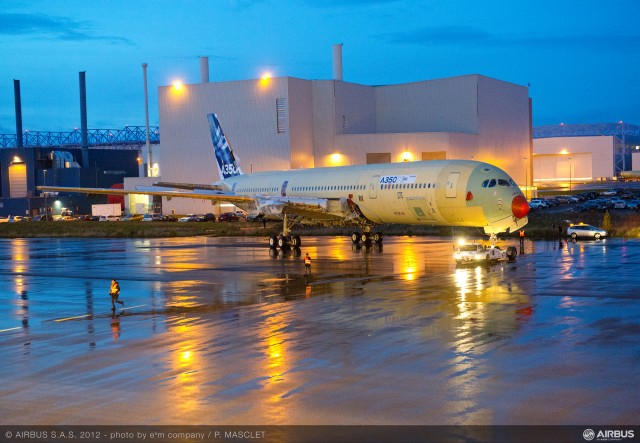
With its main structural assembly and system connections complete, the first A350 XWB flight test aircraft (designated MSN1) was moved from the main assembly hall to the adjacent indoor ground test station at Airbus’ final assembly line in Toulouse, France . Image from Airbus. Click for larger.
After the A350 XWB MSN1 exits station 30, the aircraft will go through a series of extensive production and certification / development tests, be painted and have its engines installed. It will then be delivered to the flight-line and be readied for its first flight in mid-2013.
UPDATE: Airbus has confirmed that the front doors on the A350, as shown in this photo, will be closed on the ground during normal operations. “The forward set of doors only will be open when the gear is being extended or retracted,” Airbus stated to AirlineReporter.com. “The reason that they are open in this picture is that the aircraft is not hydraulically ’œactive’ at the point when the picture was snapped and there was no reason to close the doors for the short road trip.”
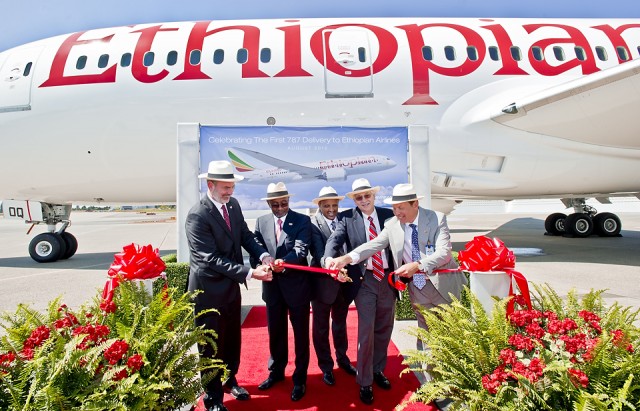
You cannot have a delivery ceremony without a ribbon cutting. Image from Boeing.
Yesterday, Ethiopian Airlines took delivery of their first Boeing 787 Dreamliner at Paine Field in Everett, WA. The aircraft is named “Africa First.”
“Today begins the first day in a new era of flying for our passengers and brings us even closer to our vision for the future, Vision 2025,” said Tewolde GebreMariam, CEO of Ethiopian Airlines. “We are pleased to be the first airline in the world outside Japan to receive this technologically advanced aircraft. We have been waiting for this airplane and now that we officially have it and will show it to the world, I can say with pride, it was worth the wait. This airplane is going to move Ethiopian Airlines to the forefront of aviation leadership around the globe.”
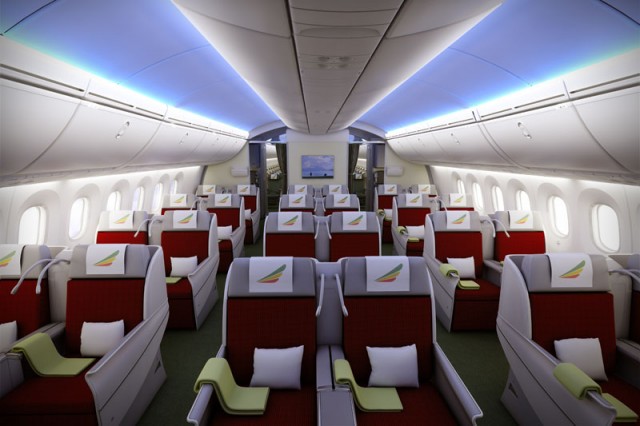
Ethiopian’s Cloud Nine (Business Class) cabin on the 787. Image from Ethiopian Airlines.
The aircraft landed in Washington DC and will continue heading west to Bole Addis Ababa International Airport (ADD) in Ethiopia tomorrow.
“Today marks not just another milestone for Boeing and Ethiopian Airlines, but a new beginning in our 65-year partnership,” said Van Rex Gallard, vice president of Sales for Africa, Latin America, & Caribbean, Boeing Commercial Airplanes during the delivery ceremony. “Ethiopian Airlines continues to show their strong leadership in African aviation and their growing presence around the globe. Being the first in Africa and one of the first in the world further confirms their position globally.”
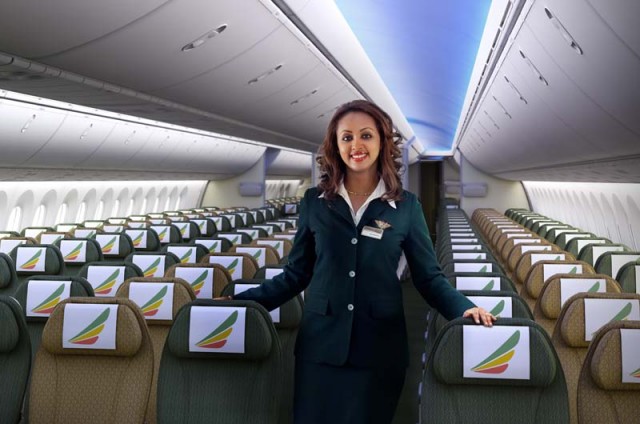
A flight attendant in the 787’s economy class. Image from Ethiopian Airlines.
Ethiopian is the first non-Japanese airline to take delivery of the Dreamliner and they have nine additional 787s on order. The airline will begin daily flights between DC and Addis Ababa using the 787 on October 20th, a route that is currently operated by a Boeing 777-200LR.
Ethiopians 787 is laid out with 24 seats in Cloud Nine and 246 seats in economy.
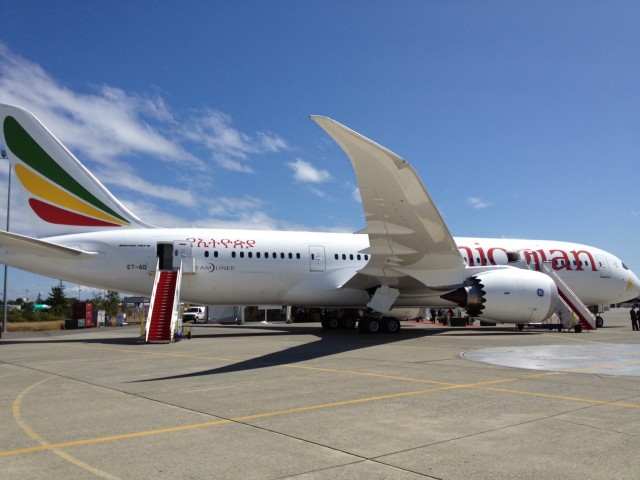
Ethiopian’s first 787 at Paine Field yesterday. Photo by Boeing.
ADDITIONAL ETHIOPIAN BOEING 787 PHOTOS:
[nggallery id=20]

Emirates Catering Facility in Dubai.
While visiting Dubai recently, I had the opportunity to check out the Emirates Catering Facility. It is the largest catering facility in the world and very impressive. I was asked to write up a story for APEX Editor’s Blog and wanted to share the story with you as well…
DUBAI: Many people do not stop and think about the effort it takes for an airline to prepare multiple meals for long-haul flights; it is complex operation and just one of the many aspects that airlines need to concentrate on to be successful.
The largest airline catering facility in the world is the Emirates Flight Catering in Dubai. Each day, the 50,000 sq m facility produces 110,000 meal trays. It operates 24 hours per day, 365 days per year, and employs 6,600 people.
Continue reading the the story on the APEX Editor’s Blog and also check out all 52 photos of the facility.
Ken Fielding shares with AirlineReporter.com another set of classic photos that have an interesting story. Here are his photos and his story in his own words…
This was a taxiing accident at Liverpool in July, 1966. It was lunchtime on a warm summer’s day and I was sitting in my office, directly in front of the aircraft’s right wing, having just had lunch and reading a book. Working at an airport so close to the ramp you no longer ‘hear’ aircraft, they just become a background noise.
Suddenly there was an enormous bang and shrieking of tortured metal. I jumped up and there was this Rolls Royce Dart engine about six feet away from my window with the prop blades bent at an interesting angle.
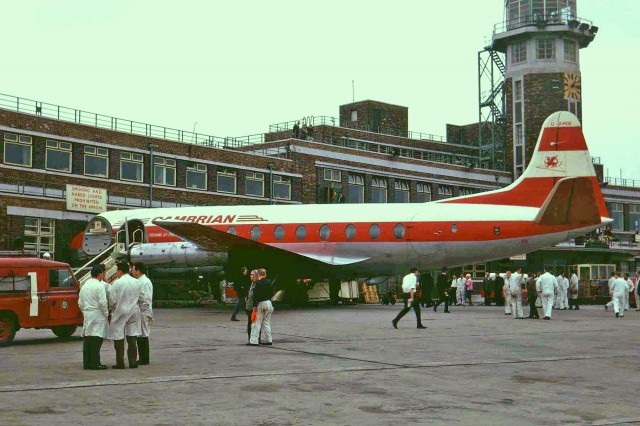
Viscount Cambrian Airways taken July 15, 1966 by Ken Fielding. Click for Larger.
That got the heart pumping a bit faster and I grabbed my camera and rushed outside. Can you imagine anyone being allowed that close to a pranged aircraft now?
The aircraft had been having hydraulic problems and had been ‘fixed’. It was being ground tested by two engineers when the hydraulics failed again, losing steering and brakes. The starboard wing hit an Aer Lingus V.800 Viscount which swung it round toward the terminal and straight into Gate 2.
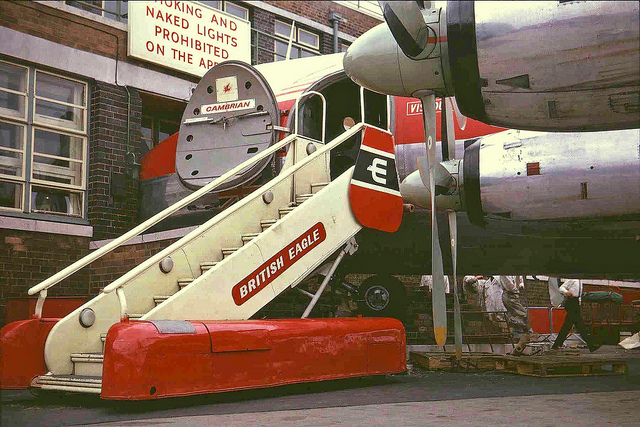
Oops. This Vickers Viscount did not stop in time. Photo by Ken Fielding. Click for Larger.
The first thing the ground crew did was straighten the props (as they would on a normal turnaround). Having demolished a couple of sets of British Eagle steps and a baggage truck, the two on the other wing needed a bit more attention. The aircraft demolished the wall at Gate 2 and you can see the broken nose-wheel resting on the wall.
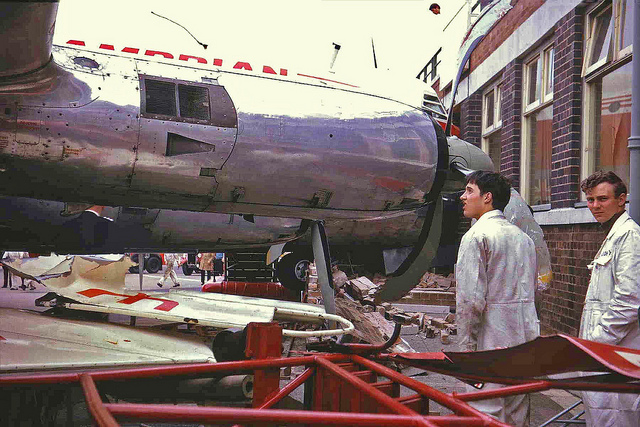
Those blades and those stairs aren't looking so great. Photo by Ken Fielding. Click for Larger.
This was outside my office window. A piece of the mangled steps can be seen (top left of center) sticking out of the aircraft roof while another piece had gone through an aircraft window.
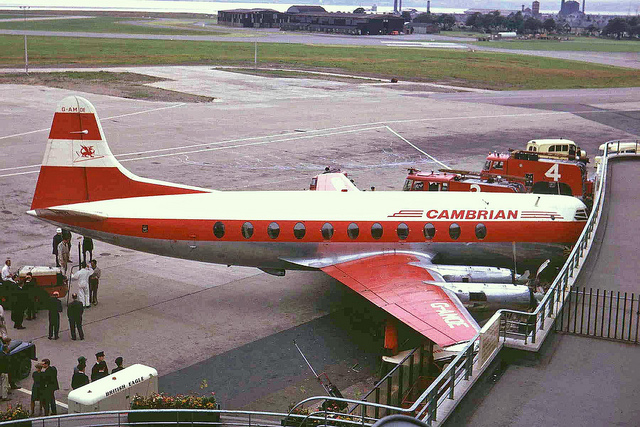
Something about this just does not look right. Photo by Ken Fielding. Click for Larger.
Cambrian Airways taxiing accident, from the upper roof terrace at Liverpool (LPL). The starboard wingtip stopped about 4 feet from my office window.
Check out Ken’s other photos on his Flickr account. If you have any questions for Ken about this incident, ask them in the comment, he will be happy to answer them.
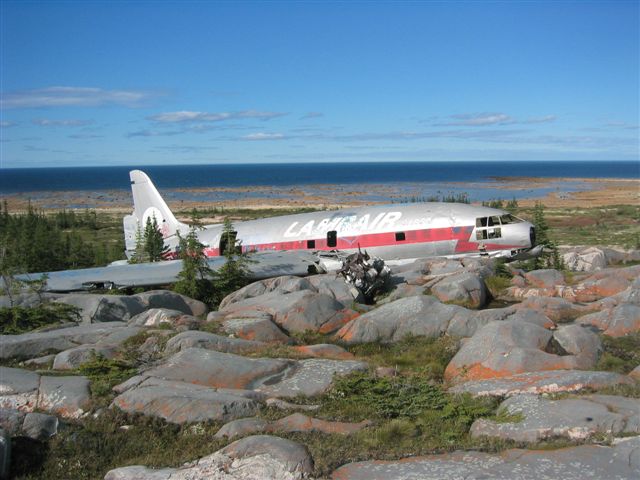
A Curtiss C-46 Commando that crashed in Churchill, Manitoba in 1979.
The far north can be a brutal place. Many towns exist, but there are not many ways to get to them and air transportation becomes a must. But what happens when an older aircraft crash lands in the middle of no where? Most times, it is not worth the cost and effort to salvage the plane and they are left to rot. Although sad, it does provide the ability for people to head north and take some amazing shots of these aging aircraft.
Ruud Leeuw took a look at some of the aircraft that have been abandoned in the great north and I felt it was something to share. Not only does Leeuw’s page have great photos of old aircraft, but also many stories to go along with them. From a B-29 that crashed landed in Greenland, to a Lockheed Lodestar that went down in northern Qubec, the collection is quite impressive. If you have a few minutes (eh, make it more than a few), be sure to check out his site.
Thanks Dave for pointing this one out.












